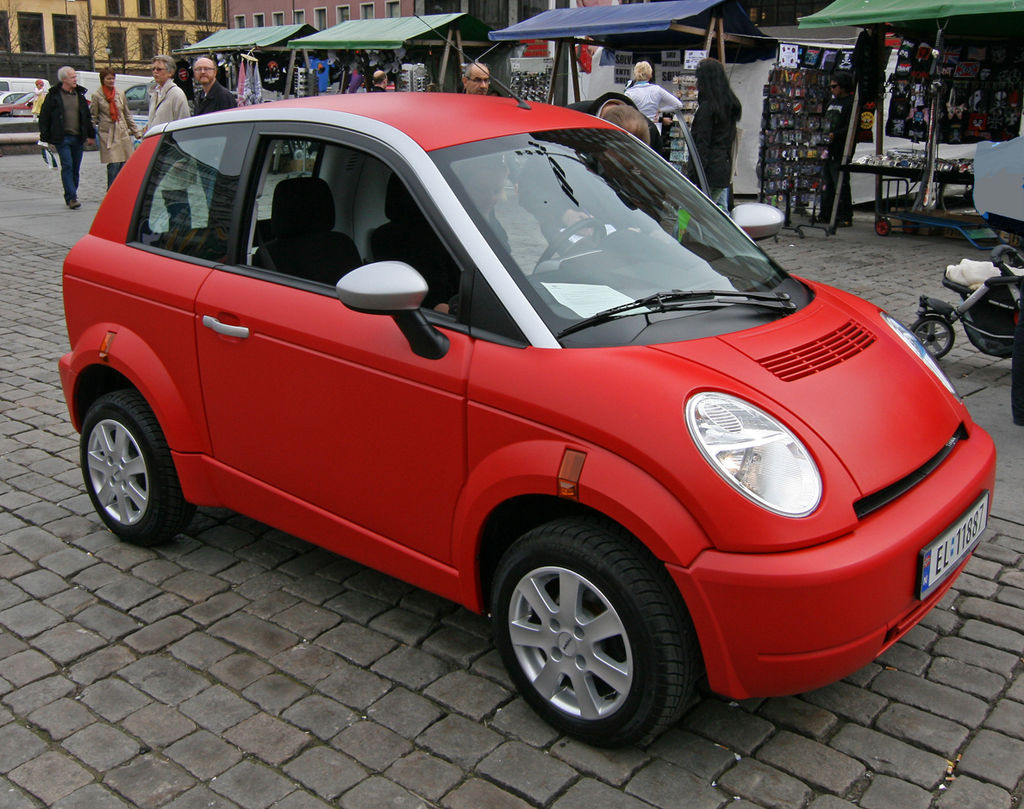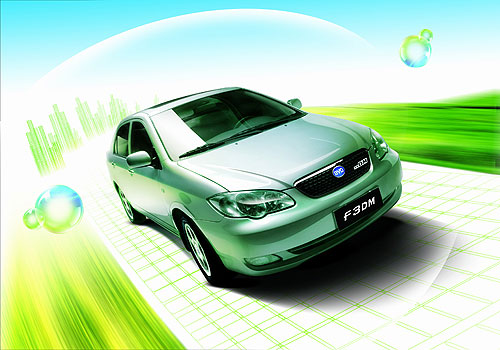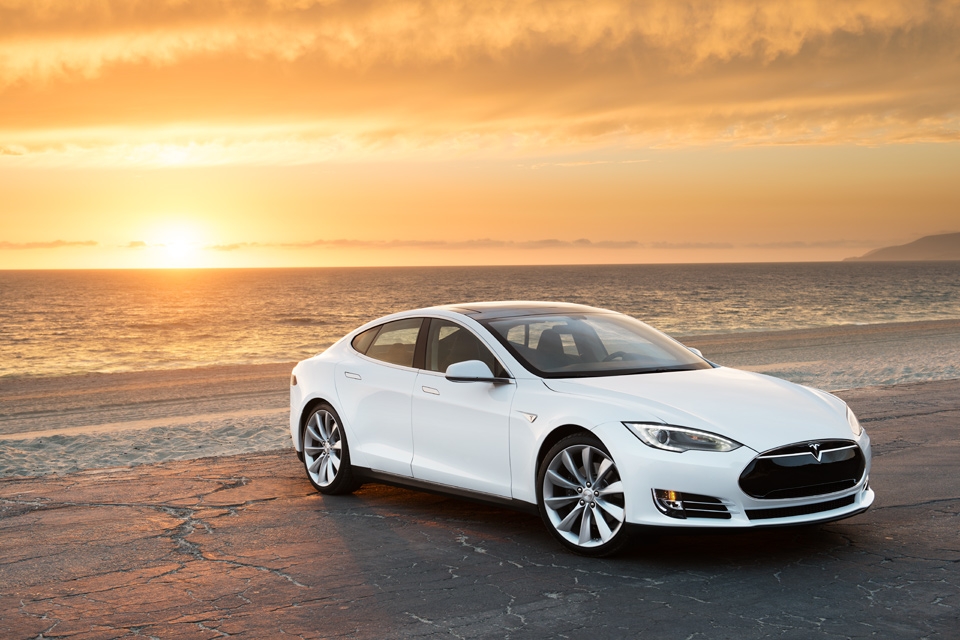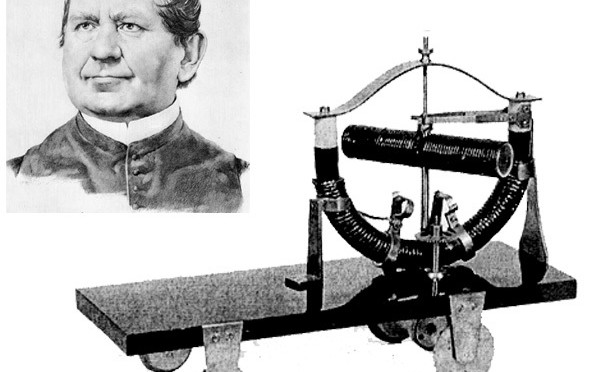1828: Hungarian inventor Ányos Jedlik, who had invented an early electric motor, builds a small, model car powered by this motor.
1834: Vermont blacksmith Thomas Davenport and his wife Emily build a small, model electric car that runs on a circular, electrified track. The Davenports use silk from Emily’s wedding dress as wiring.
1835: In the Netherlands, Professor Sibrandus Stratingh of Groningen and his assistant, Christopher Becker, build a small electric car powered by primary cells (nonrechargeable batteries). (Image on right.)
1837: Thomas & Emily Davenport, and colleague Orange Smalley, receive the first American patent for an electric machine/motor.
1837 & 1841: Large-scale “electric cars” are finally built by chemist Robert Davidson of Aberdeen. Powered by galvanic cells, the larger one, built in 1841, can pull 6 tons at 4 miles per hour for about 1½ miles. It weighs 7 tons. Sadly, it is soon destroyed by railway workers who see it as a potential threat to their livelihood (even though electric cars were still far from economical, with the cost of using zinc in a battery being about 40 times higher than the cost of burning coal in a firebox).
1859: French physicist Gaston Planté invents the lead-acid battery, which actually makes practical electric cars a possibility. (Lead-acid batteries are still used in some electric cars today, and are used in gas-powered cars to help start the engines. However, most modern electric cars use lithium-ion batteries. The lead-acid batteries used to start cars are still very similar to what Gaston created.)
1881: French scientist Camille Alphonse Faure greatly improves the design of lead-acid batteries, increasing their capacity substantially. This leads to industrial-scale production of lead-acid batteries.
1881: An electric tricycle built by Gaston Planté is displayed at the International Exhibition of Electricity in Paris.
1881: Parisian engineer and carriage builder Charles Jeantaud, with the help of Camille Alphonse Faure, builds an electric car using a Tilbury-style buggy, a Gramme motor, and the Fulmen battery.
1881: Englishmen William Ayrton & John Perry build an electric tricycle, the first vehicle to use electric lights. It uses lead acid cells, has a range of 10 to 25 miles, and has a maximum speed of 9 mph.
1884: English inventor Thomas Parker builds in first practical production electric car in London. He uses “high-capacity” rechargeable batteries that he designed. (Parker also electrified the London Underground, was responsible for overhead tramways in Liverpool and Birmingham, and has other such accomplishments to his name.)
1884: College dropout Andrew Riker, while living in his parents’ basement, develops an electric trike using lead-sulfuric acid batteries that has 25 miles of range.
1888: Andrew Riker forms the Riker Electric Vehicle Company, which is based in Elizabeth Port, New Jersey.
1888: Philip Pratt demonstrates an electric tricycle built for him by Fred M. Kimball of Fred M. Kimball Company. Despite Riker’s (lesser known) electric trike being built a few years earlier, many say that Pratt’s electric trike is the first in the US, and Pratt is often given the title, “father of the American electric automobile.”
1888: The first electric car in Germany is built by Andreas Flocken.
1888: Elwell-Parker Company and rivals merge in England to form the Electric Construction Corporation. The Electric Construction Corporation thus gains a monopoly on the production of electric cars in the coming decade.
1890-1891: The first American electric car is built by William Morrison of Des Moines, Iowa. The 6-passenger wagon can travel up to 23 km/h (14 mph). The car may also be the first land vehicle steered with a wheel. Morrison, a chemist, moved to Iowa from Scotland in 1880.
1893: William Morrison’s electric car is shown at the “World’s Colombian Exposition” in Chicago, seen by basically everyone who would become influential in the early years of electric vehicle development.
1894: Louis Antoine Krieger begins building electric “horseless carriages” in Paris. They use regenerative braking, with the captured energy stored in a battery and later used to help power the motor.
1894: Mechanical engineer Henry G. Morris and chemist Pedro G. Salom build the first “successful” electric car. With backgrounds in the dwindling battery streetcar market, Morris and Salom develop the “Electrobat” like a small battery streetcar. It has a top speed of 15 mph and uses a lead acid battery. It goes into production the following year, 1895.
1895: The first known US auto race is won by an electric vehicle.
1896: The first car dealer is set up in the US. It only sells electric vehicles.
1896: Morris and Salom build a 2-seat “Electric Road Wagon” and form the “Electric Carriage and Wagon Company,” apparently the first electric car company in the US. Developed as coupes and hansoms for New York City taxis, the Electric Road Wagons each have rear-wheel steering, two 1/2 hp motors, 44 lead-acid cells, and a range of 30 miles.
1896: To overcome range limitations and lack of charging infrastructure, a battery exchange (aka battery swap) service is proposed. Implemented by Hartford Electric Light Company, the service is initially available for electric trucks.
1897: A fleet of electric vehicle taxis is brought to London by Walter C. Bersey. They receive the nickname “Hummingbirds” because of the light humming sound they make.
1897: A fleet of electric hansom cabs is brought to New York City by Samuel’s Electric Carriage and Wagon Company.
1897: The first car with power steering is built. It’s an electric car.
1898: Dr. Ferdinand Porsche, 23 years old, builds his first car, the Lohner Electric Chaise. It has a hub motor at each driving wheel and is reportedly the first front-wheel-drive car in the world.
1898: Count Gaston de Chasseloup-Laubat of Paris sets the first known speed record in a car, going faster than any human before at 39.245 mph (62.8 km/h) in his electric Jeantaud. This earns him the nickname “Electric Count.” Incidentally, the world record lasts for just a few days before being beaten by another electric vehicle.
1899: Camille Jenatzy and Count Gaston de Chasseloup-Laubat trade speed records several times throughout the year, ending in Camille Jenatzy breaking the 100 km/h (62 mph) speed barrier in an electric vehicle. He reaches a top speed of 105.88 km/h (65.79 mph). Jenatzy’s vehicle is named La Jamais Contente (“The Never Satisfied”), picture on right.
1899: Riker Electric Vehicle Company, Electric Carriage and Wagon Company, Electric Storage Battery, and Samuel’s Electric Carriage and Wagon Company merge to form the “Electric Vehicle Company,” attempting to create a monopoly in the US electric vehicle market.
1899: MIT electrical & mechanical engineering graduate Clinton Edgar Woods incorporates Woods Motor Vehicle Company, 3 years after forming American Electric Vehicle Company, which then became Waverly Company.
1899: The Baker Electric, the first production electric car, is born. It is produced by Baker Motor Vehicle Company.
1900: 38% of US automobiles, 33,842 cars, are powered by electricity (40% by steam, and 22% by gasoline).
1901: Thomas Edison patents the nickel-iron battery.
1902: Dr. Ferdinand Porsche builds second car, a hybrid with an electric range of 40 miles.
1902: Walter Baker goes 104 mph (167 km/h) in his electric “Road Torpedo,” setting a new world speed record in Ormond Beach, Florida. It is also the first vehicle to utilize a safety belt. Later, he reportedly reaches 127 mph (204 km/h) but without officially being recorded. He later builds an even more powerful vehicle, but he crashes into the crowd at Staten Island Speedway, killing two spectators, and never races again. His 104 mph record stands for 64 years.
1907: Detroit Electric, an electric car produced by the Anderson Electric Car Company, is born. 13,000 Detroit Electrics are produced between 1907 and 1939.
1908: Thomas Edison improves the design of his nickel-iron battery.
1908: Henry Ford starts producing the Model T, but he also buys his wife, Clara, a Detroit Electric Model C coupe (since she preferred electric cars). The Detroit Electric Model C coupe comes with a special baby seat. (The Ford family eventually buys a second Detroit Electric, a Model D, officially sold to Edsel Ford; and then a third one, a Model 47, for Clara.)
1911: The first gasoline-electric hybrid car is released by Woods Motor Vehicle Company, which is based out of Chicago.
1912: 38,843 electric vehicles are on the roads in the United States.
1912: The electric starter is invented by Charles Kettering. Ironically, this harms the electric car market, as gasoline-powered cars can now be easily and quickly started (without having to use a hand crank).
1913: Mass production of the Ford Model T on the first modern assembly line deals a strong blow to early-era electric cars, as it brings down the cost of gasoline cars considerably (making electric cars two or even three times more expensive in the coming years). Electric car sales would slowly taper off over the coming years. (Other main factors leading to the demise of electric cars were: cheap Texas oil; a more developed road network and the ability/desire to travel long distances — electric cars typically had driving ranges of 30 to 40 miles (50 to 65 kilometers) and limited charging infrastructure; the electric starter — see above; slower speeds — about 20 mph or 32 km/h; tough economic times during World War I; and the stigma that electric cars are for women.)
1914: Baker Motor Vehicle Company merges with Cleveland automaker Rauch and Lang to become Baker, Rauch & Lang.
1923: Milburn, one of few remaining electric vehicle companies, sells out to main body client General Motors.
1929: W. C. Anderson, 75 years old and in poor health, sells his Detroit Electric company. The last entirely new Detroit Electric was likely sold in 1926 anyway.
1957: Sputnik is launched and the US space program engages in advanced battery research & development.
1959-1961: The Henney Kilowatt, a small electric car, is produced by Henney Coachworks and the National Union Electric Company. It achieves a top speed of 60 mph (97 km/h) and a range of 60 miles (97 kilometers), but its high price keeps away potential buyers.
1967: The Electric Auto Association is founded by Walter Laski.
1967-1969: American Motors Corporation (AMC) & Gulton Industries team up to produce a few electric cars using a lithium-based battery and a nickel-cadmium battery, such as the
Amitron (1967, lithium batteries) and and all-electric
Rambler American (1969, nickel-cadmium batteries). The Amitron introduces regenerative braking.
1971: The first manned vehicle to drive on the moon, the Lunar Rover, is an electric car.
1972: The Electric Auto Association holds its first annual electric vehicle rally.
1973-1977: The Enfield 8000 (pictured above) is built by Enfield Automotive in the UK. Using lead-acid batteries, the car has a top speed of 48 mph (77 km/h) and a top range of about 40 miles (64 kilometers).
1976: The US Congress passes the Electric and Hybrid Vehicle Research, Development, and Demonstration Act, which increases research and development of electric motors, batteries, and other components of electric and hybrid vehicles.
1977: AMC & Gulton Industries again team up to produce the
AMC Electron, a 3-passenger, electric, commuter, city car. (Pictured above.)
1983: A fleet of electric vehicles drive from San Jose to San Francisco and back (100 miles / 161 kilometers) without recharging.
1985: Saied Motai drives an electric vehicle 230 miles (370 kilometers) on a single charge.
1990: General Motors (GM) introduces the GM Impact, an electric concept car, at the Los Angeles Auto Show. GM President Roger Smith also announces that GM will produce electric cars for the consumer market (which finally happens in 1997, but the car is only available to lease).
1990: The California Air Resources Board (CARB), the government of California’s “clean air agency,” pushes for automakers to produce more-fuel-efficient, low-emissions vehicles and eventually transition to zero emissions vehicles (e.g., electric vehicles). The main law is the Zero Emission Vehicle (ZEV) Mandate, which requires 2% of California’s vehicles to have 0 tailpipe emissions by 1998, and 10% by 2003. As a result, automakers develop several electric vehicle models in the coming years. However, the automakers don’t really get behind the idea, don’t market their electric vehicles well (if at all), and eventually sue CARB, resulting in a dropping of the ZEV Mandate.
1991: The
Kewet, a 100% electric microcar produced in Norway, is introduced. (Pictured above.)
1992: The Škoda Favorit ELTRA 151L & 151 Pick-Up is released, selling for under $20,000 without subsidy. It has a top speed of 50 mph (80 km/h) and a top range of 50 miles (80 kilometers).
1992: California passes a $1,000 tax credit for electric vehicles.
1994: 12 other US states adopt California’s ZEV Mandate.
1994: The GM Impact EV (later named the EV1) drives 187 mph (301 km/h), breaking the electric vehicle speed record.
1994: The REVA Electric Car Company is formed in India, a joint venture between the Maini Group India and AEV of California.
1996: GM releases the EV1 (pictured above). It has a top speed of 80 mph (129 km/h) and a top range of 160 miles (257 kilometers). It is produced until 2003, but is only available for lease. And GM reclaims and destroys the electric cars, not allowing owners in love with the vehicle to buy them off of GM. EV1s that were donated to engineering schools and museums are not reclaimed but are deactivated. (Honda, Nissan, and Toyota similarly offered their vehicles under closed-ended leases and repossessed/crushed them at the end of the lease periods.)
1997: GM releases the Chevrolet S10 EV, an electric pickup truck. It has a top speed of 73 mph (118 km/h) and a top range of 90 miles (144 kilometers). It is produced until 1998.
1997: Honda releases the EV Plus, which has a top speed of over 80 mph (130 km/h) and a top range of 80 to 110 miles (130 to 180 kilometers). It is produced until 1999.
1997: Toyota releases the RAV4 EV, which has a top speed of 78 mph (125 km/h) and a top range of 87 miles (140 kilometers). It is produced until 2002.
1998: Ford releases the Ranger EV, which has a range of 74 miles (119 kilometers). It is produced until 2002.
1999: The Honda Insight and Toyota Prius, hybrid electric cars, go on sale in the US. These are the first hybrid vehicles on the US market since the 1917 Woods hybrid.
2001: REVA Electric Car Company releases the REVAi (aka “G-Wiz” in the UK), an electric microcar powered by lead-acid batteries (pictured above).
2002: GM and DaimlerChrysler finally sue CARB over the ZEV Mandate, and are joined in the suit by the Bush Administration. They win the lawsuit and the California ZEV Mandate is changed to allow ZEV credits instead of ZEVs.
2003: Tesla Motors is founded in California.
2004: Tesla Motors begins work on the Tesla Roadster, a 100% electric sports car based on the design of the popular and stylish Lotus Elise.
2006: Tesla Motors unveils the Tesla Roadster (pictured above) at the San Francisco International Auto Show. The car changes the image of electric cars for many, and also spurs some major automakers to genuinely jump into the electric car market.
2007: The Kewet gets rebranded as “
Buddy.”
2008: The
Th!nk City electric city car (pictured above) goes into production in Norway.
2008: The Tesla Roadster becomes the first production electric vehicle to use lithium-ion battery cells as well as the first production electric vehicle to have a range of over 200 miles on a single charge.
2008: While campaigning for the presidency, Barack Obama states that he would push for 1 million plug-in hybrid and electric vehicles on US roadways by 2015 if elected president.
2009: BYD releases the world’s first plug-in hybrid compact sedan, the F3DM (pictured above). It uses lithium-iron-phosphate batteries, which have less energy density but are more stable than lithium-ion batteries used in the Tesla Roadster.
2009: REVA Electric Car Company releases the REVA L-ion, an updated version of its electric microcar this time powered by lithium-ion batteries.
2009: $2 billion goes toward the development of electric vehicle batteries and related technologies under the American Recovery and Reinvestment Act of 2009, and another $400 million goes toward the development of plug-in vehicle charging infrastructure.
2009: The UK announces a £2,000 subsidy for consumer electric cars.
2009: The US Department of Energy awards $8 billion in fuel-efficient vehicle loans to Ford, Tesla Motors, and Nissan, part of $25 billion dedicated for such a purpose under the Energy Independence and Security Act of 2007.
2009: Tesla unveils the Model S electric sedan (pictured above), which quickly gets top ratings from leading auto journalists and consumer technology review company Consumer Reports. By many, it is considered the best mass-production car of any type in the world.
2009: The Mitsubishi i-MiEV (pictured above) goes on sale in Japan. It hits the European, Chinese, and Australian markets in 2010; and then the US and other markets in 2011.
2010: Mass production of the 100% electric Nissan Leaf (pictured above) begins in Japan, and the car is sold in Japan and the US. It has a max speed of over 90 mph (145 km/h), has a top range of 100 miles (161 kilometers), and can be recharged to 80% of battery capacity in 30 minutes.
2010: Production of the BYD e6 (pictured above) begins in China, initially just for fleet customers.
2010: Mass production of the Chevy Volt (pictured above), an extended-range electric vehicle (also referred to as a plug-in hybrid electric vehicle), begins in the US. The instigation of this car and possibly all other modern plug-in cars was the Tesla Roadster. Bob Lutz, who was vice chairman of GM at the time, said in 2009: “All the geniuses here at General Motors kept saying lithium-ion technology is 10 years away, and Toyota agreed with us – and boom, along comes Tesla. So I said, ‘How come some tiny little California startup, run by guys who know nothing about the car business, can do this, and we can’t?’ That was the crowbar that helped break up the log jam.”
2010: Tesla Motors goes public with an IPO on NASDAQ.
2010: ~25,000 electric cars are on the roads globally (fewer than were on US roads in 1912, but many more than just a few years prior).
2011: The Bolloré Bluecar is released in France, initially just used in Paris’ Autolib’ carsharing program.
2011: The Mitsubishi i-MiEV becomes the first electric car to see more than 10,000 sales (including under various other badges — Citroën C-Zero and Peugeot iOn).
2011: ~80,000 electric cars are on the roads globally, more than three times the number from the year before.
2012: Tesla unveils the Model X, an electric SUV/crossover with similar performance to the Model S.
2012: Tesla begins building a North American
Supercharger network, which Tesla owners can use for free.
2012: ~200,000 electric cars are on the roads globally, 2.5 times more than the year before.
2013: The Nissan Leaf becomes the first electric car to see over 50,000 sales.
2013: The Nissan Leaf gets a $6,000 price cut in the US thanks to the start of production in the US (Tennessee).
2013: For certain months, the Nissan Leaf and the Tesla Model S each become the top-selling car of any type in Norway.
2013: The Renault–Nissan Alliance passes 100,000 plug-in electric vehicle sales globally, the first company to do so.
2013: ~405,000 electric cars are on the roads globally, more than twice the number from the year before.
2014: Numerous 100% electric and plug-in hybrid electric vehicles are now on the market, such as: BMW i3, BMW i8, Bolloré Bluecar, BYD e6, BYD Qin, Cadillac ELR, Chevy Spark EV, Chevy Volt, Citröen Berlingo Électrique, Citröen C-Zero, Fiat 500e, Ford C-Max Energi, Ford Fusion Energi, Ford Focus Electric, Honda Accord Plug-in, Honda Fit EV, Kia Soul EV, Mercedes-Benz B-Class Electric, Mia Electric, Mitsubishi i-MiEV, Mitsubishi Outlander Plug-in, Nissan e-NV200, Nissan Leaf, Opel Ampera, Peugeot iOn, Peugeot Partner EV, Porsche Panamera S-E Hybrid, Renault Kangoo ZE, Renault Twizy, Renault Zoe, Smart Electric Drive, Tesla Model S, Tesla Model X, Toyota Prius Plug-in, Toyota RAV4 EV, Via Motors VTRUX SUV/Truck/Van, Volvo C30 Electric, Volvo V60 Plug-in, Volkswagen e-Golf, Volkswagen e-Up!, Volkswagen XL1, Wheego LiFE, Wheego Whip.
2014: Tesla announces plans to build a battery “gigafactory” in order to ensure it has enough batteries for its current and upcoming vehicles.
2014: Tesla opens up its patents to anyone wanting to use them “in good faith.”
2014: Tesla announces that its 3rd-generation, much more affordable vehicle will be called Tesla Model III. It is supposed to have a range of about 200 miles (320 kilometers), be about 20% smaller than the Model S, have a base price of about $30,000, and go into production in 2017.
2014: Tesla starts working on production of the Model X.
2014: The Nissan Leaf becomes the first electric car to see over 100,000 sales.
























